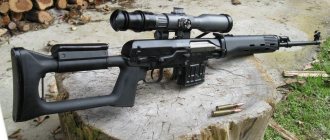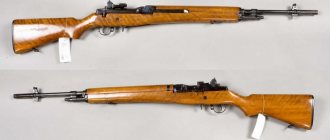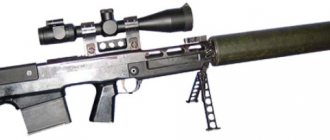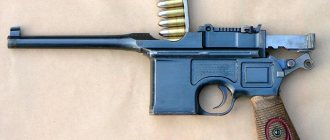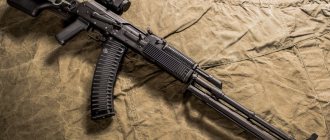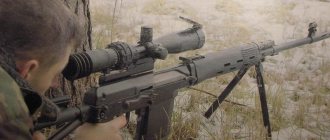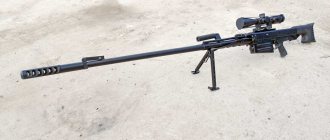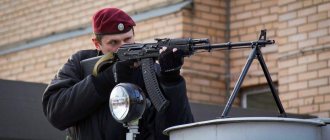Rifle VSSK Exhaust – video
The silent large-caliber sniper rifle “Exhaust” was developed at TsKIB SOO (Central Design Bureau for Sports and Hunting Weapons, Tula, branch of the Instrument Design Bureau) in 2002, by special order of the Special Purpose Center (TSSN) of the FSB of Russia. The rifle (more precisely, the VSSK “Vykhlop” sniper complex, consisting of weapons and ammunition for them, index GRAU 6S8) was first publicly demonstrated in the fall of 2005 at the Interpolitex exhibition in Moscow. As far as we know, the Vykhlop complex was produced in small quantities and is in service with the units of the TsSN of the FSB of Russia.
The main purpose of the VSSK “Vykhlop” sniper rifle is low-noise and flameless destruction of protected targets (cars, other unarmored vehicles, manpower wearing heavy body armor or hiding in vehicles, etc.) at ranges of up to 600 meters. At the same time, due to the use of a bullet with a subsonic initial speed (about 290-295 m/s) in combination with an effective silencer, a significant reduction in the sound level of the shot is ensured (shot volume at 123 dB). Greater effectiveness against a target is achieved by using heavy large-caliber bullets weighing 59 grams (SC-130PT cartridge with increased accuracy) and even 76 grams (SC-130VPS cartridge with increased penetration ability). For the STs-130PT cartridge, the accuracy of fire is 25mm at a range of 100 meters (1 MOA / minute of arc), for the STs-130VPS cartridge - guaranteed penetration of a 16mm steel plate at a range of 200 meters or heavy body armor of protection class 5 (according to GOST) at a range of 100 meters .
The cartridges use specially made bullets and relatively short cylindrical sleeves - the total length of the 12.7mm STs-130 cartridge is 97mm versus 145mm for the “regular” domestic large-caliber 12.7x108 cartridge. Due to the relatively small (for the chosen caliber, of course) muzzle energy, weapons for this weapon turned out to be almost two and a half to three times lighter than rifles chambered for “regular” large-caliber cartridges 12.7x108 or 12.7x99. However, the muzzle energy of the STs-130PT cartridge bullet is about 2500 Joules (3,650 J for the STs-130VPS cartridge), and due to the heavy bullet with a high ballistic coefficient, the energy is better retained along the bullet trajectory compared to “regular” sniper cartridges of the caliber 7.62mm or “silent” 9mm cartridges when firing from the VSS “Vintorez” rifle.
Partial disassembly of VSSK Exhaust
It should be noted that such a development (a large-caliber, low-noise rifle chambered for a special “weakened” cartridge) is not unique. Back in the mid-1990s in the United States, the famous specialist in special cartridges J.D. Jones (JDJones), working for SSK Industries, created the .500 Whisper cartridges, using a shortened case from the .460 Weatherby Magnum hunting rifle cartridge in combination with a precision 12.7 caliber bullet mm, which had excellent ballistics. The muzzle velocity and bullet weight of .500 Whisper cartridges are comparable to those of 12.7mm STs-130 cartridges, and they are used in specially modernized magazine or even single-shot rifles (created on the basis of hunting rifles), equipped with a silencer and optical sights. In addition to the Whisper series cartridges, other ammunition and weapons of similar purposes and calibers are also produced in limited quantities in the United States, but there is no reliable information yet about whether such weapons are used by intelligence agencies or law enforcement units in the United States and other countries.
The VSSK “Vykhlop” special large-caliber sniper rifle is built in a bullpup configuration and has an integral silencer that is removable for transporting or cleaning the weapon. The reloading mechanism is manual, with a longitudinally sliding bolt controlled by a handle on the right side of the weapon. The barrel is locked by a rotating bolt cylinder. Single-stack detachable box magazine holds 5 rounds. On the top of the rifle's receiver there are mounts for optical or night sights; in addition, the rifle is equipped with backup open sights (front and rear sights) made on folding bases. In front of the short plastic forend there is a folding bipod.
Ammunition
The ammunition for this powerful weapon deserves special attention. For combat shooting, three types of special large-caliber 12.7×55 mm cartridges of the STs-130 line with subsonic bullet speed are used:
— sniper STs-130 PT with increased accuracy with a shell bullet; — sniper STs-130 PT2 of increased accuracy with a solid (single-component) bronze bullet; — sniper STs-130 VPS with high penetration ability with an armor-piercing bullet with a heat-strengthened core protruding from the shell; — training STs-130 PU, designed for training in weapon handling techniques and testing the operation of weapon mechanisms.
Large-caliber machine gun cartridges. 12.7 mm heavy machine gun cartridges
12.7 mm heavy machine gun cartridges
Domestic large-caliber machine gun cartridges date back to October 27, 1925, when the Revolutionary Military Council of the USSR proposed to the Artillery Committee of the Artillery Directorate of the Red Army to develop a 12-20 mm machine gun by May 1, 1927.
In the design bureau (PKB) of the First Tula Arms Factories (TOZ), under the leadership of I. A. Pastukhov, a machine gun was created based on the 12.7 mm English large-caliber Vickers cartridge, which received the designation “P-5” - “machine gun 5” -linear” (that is, 0.5-inch caliber). The following year, 1928, the head of the Design Bureau of Kovrov Plant No. 2, V. A. Degtyarev, also received the task of developing, on the basis of his DP light machine gun, a heavy machine gun for anti-tank and air defense chambered for the English 12.7 mm cartridge. Locking in the first model of his machine gun was similar to the design of the DP machine gun, and power was supplied from a rigid metal cassette similar to the Hotchkiss M.1914 machine gun. Problems that arose with ammunition for heavy machine guns forced Soviet designers to abandon direct copying of English 12.7 mm cartridges and begin work on designing their own cartridges that would meet the requirements of the time. Only after the creation of such a cartridge by specialists from the Cartridge-Tube Trust in 1930, Degtyarev was able to present two versions of his heavy machine guns to Artkom as quickly as possible.
The report of the Revolutionary Military Council of the USSR dated December 1929 stated: “The adopted system of infantry weapons of the Red Army provides for in the near future the introduction into service of a semi-automatic self-loading rifle, a self-loading pistol, a submachine gun, a heavy machine gun - to combat armored units and air enemies, caliber 18-20 m/m with a working rate of fire of up to 500–600 rounds...” In 1930, in the workshop of the Bureau of New Designs and Standardization (as the PKB was renamed) of Plant No. 2, the first prototype of the Degtyarev heavy machine gun with a flat disk magazine designed by A. S. Kladov with a capacity of 30 was assembled cartridges. In February 1931, two 12.7-mm machine guns were tested - the “Dreyse TOZ manufacturing system” and the Degtyarev system. The commission that conducted the tests gave preference to the Degtyarev large-caliber (DK-32) as lighter and easier to manufacture. The DK was adopted, production of a small series began at plant No. 2 in Kovrov in 1932, but in 1933 only 12 pieces were assembled, and in 1934 the production of the Degtyarev heavy machine gun was completely suspended.
1. 12.7 mm cartridge with a tracer bullet with a lead core T-38, 2. 12.7 mm cartridge with an instantaneous incendiary bullet MDZ-46
For the Degtyarev heavy machine gun, the caliber 12.7 mm was chosen. A new cartridge with an armor-piercing bullet was designed at the Tula Cartridge Plant in 1928–1930. The 12.7 mm large-caliber cartridge consisted of: a bimetallic bottle sleeve 108 mm long without a rim with a groove; a charge of smokeless pyroxylin powder 4/1 fl and an armor-piercing B-30 bullet, modeled after the 7.62-mm armor-piercing bullet B-30 mod. 1930 with a steel core and a cylindrical tail. Cartridge weight: 132.2–139.8 g.
A brass bottle wafer sleeve serves to connect all parts of the cartridge, while the method of fastening the bullet is a tight fit and a 2-row segmental crimp of the sleeve neck. The cartridge case has: a body, inside of which a powder charge is placed; a ramp for resting on the chamber cone; the barrel into which the bullet is inserted; a recess for the ejector hook and a bottom. The bottom of the case body has: a socket for the primer; an anvil on which the primer is broken by the striker; two priming holes through which the flame from the primer penetrates to the gunpowder. The capsule serves to ignite the charge. It consists of a brass cap with a shock compound pressed into it, covered with foil. The powder charge consists of smokeless powder. When the charge burns, powder gases are formed, the pressure of which ejects the bullet from the barrel and the entire moving system is activated to fire the next shot.
Due to the fact that the main task of the DK-32 machine gun, for which this cartridge was developed, was the destruction of lightly armored targets, cartridges with armor-piercing bullets mod. 1930 and armor-piercing incendiary mod. 1932. In addition, before the Great Patriotic War, aircraft machine guns were also developed for this promising 12.7-mm large-caliber cartridge by three design teams: V. A. Degtyarev (TsKB-2); Ya. G. Taubina and M. N. Baburina (OKB-16); and M.E. Berezin (TsKB-14), as well as several designs of anti-tank rifles, including Sholokhov, Rukavishnikov, Vladimirov and others.
Subsequently, in the late 1930s and during the Great Patriotic War, the 12.7 x108 large-caliber cartridge was repeatedly modernized by creating new bullets:
- T-38 - tracer bullet with a lead core,
- BS-41 - armor-piercing incendiary bullet,
- BZT-44 - armor-piercing incendiary tracer bullet,
- MDZ - instantaneous incendiary fragmentation bullet.
Currently, large-caliber cartridges with armor-piercing incendiary bullets B-32, armor-piercing incendiary tracer BZT-44 and fragmentation incendiary bullets MDZ are mainly used. 12.7x108 cartridges are used for firing from DShK/DShKM heavy machine guns; NSV and their variants, as well as UB aircraft machine guns; A-12.7 A; YakB-12.7. The production of 12.7 mm large-caliber cartridges was established at cartridge factories No. 3; 17; 46; 188; 335.
1. Armor-piercing incendiary bullet B-32, 2. Armor-piercing incendiary tracer bullet BZT, 3. Fragmentation incendiary bullet MDZ
Here, speaking about large-caliber machine gun cartridges, it should be noted that in general, a solid (lead) bullet is called common in small arms ammunition or tombak), or consisting only of a shell and not having an armor-piercing core, i.e. not being special - tracer, armor-piercing, armor-piercing incendiary, sighting, etc. But in relation to large-caliber machine guns that do not have (with rare exceptions, mainly in the past) of the ordinary bullet itself, due to its inappropriateness for such a caliber, armor-piercing bullets (as bullets for the main purpose) are armor-piercing, armor-piercing incendiary, armor-piercing incendiary tracer, etc., having a conventional armor-piercing core made of hardened steel. Special, in relation to large-caliber machine guns, are bullets equipped with a special armor-piercing core made of hard, tungsten-containing alloys.
12.7 mm armor-piercing bullet B-30 mod. 1930, weighing 51.1–51.9 g, consisted of a steel, tombac-clad (bimetallic) shell, a lead jacket and a steel hardened pointed core with a length of 52.48–52.88 mm, a diameter of 19.4–19.9 mm and a mass 29.25–30.50 g. The core was made of cold-drawn heat-treated tool steel of grade U12 A. The lead jacket was intended to ensure tight mounting of the bullet, soften the load on the barrel when the bullet cuts into the rifling and protect the bore from excessive wear. The length of the bullet with a conical rear part was 62.6–63.5 mm. 12.7 mm armor-piercing bullet B-30 mod. 1930 had an initial speed of 830–850 m/s and at a distance of 500 meters penetrated armor up to 16 mm thick. Muzzle energy was 18,000 J.
Large-caliber cartridges with the B-30 bullet were produced with a brass sleeve. The fixation of a 12.7 mm large-caliber cartridge with a non-protruding rim in the chamber was carried out by sloping the cartridge case into the chamber slope, which, in turn, increased the requirements for the manufacture of chambers and sleeves.
The tip of the B-30 bullet was painted black. When hitting an armored barrier, the bullet core destroyed the lead jacket and the bullet casing, and then pierced the barrier, hitting the crew of the armored vehicle, as well as its instruments and equipment. Possessing significant armor penetration, the B-30 bullet at the same time had a major drawback, which was its low armor protection. Production of this cartridge began in the early 1930s. With the start of production of large-caliber cartridges with the more universal armor-piercing incendiary bullet B-32, the production of 12.7 mm cartridges with the B-30 bullet was discontinued. During the Great Patriotic War, the DShK heavy machine gun was used as an anti-aircraft weapon, and when firing armor-piercing bullets, the B-30 could shoot down an enemy aircraft, which at that time was flying quite high - more than 2000 m and at a high speed of 500 km/h. At the same time, cartridges with armor-piercing B-30 bullets for it had limited use and were gradually replaced from circulation by cartridges with more universal armor-piercing incendiary bullets B-32, equivalent in armor penetration, but additionally providing an incendiary effect due to the presence of an incendiary composition between the warhead core and jacket of the bullet.
1. 12.7 mm cartridge with armor-piercing incendiary bullet B-32 mod.
1932 (57-BZ-542), 2. 12.7 mm cartridge with armor-piercing incendiary bullet BS-41 mod. 1941 In 1933, a new machine gun cartridge of 12.7 x108 mm caliber with a brass sleeve and an armor-piercing incendiary bullet B-32 arr. was adopted for the Degtyarev DK-32 heavy machine gun. 1932 (GRAU index - 57-BZ-542), designed for firing at enemy personnel and equipment, which had high power and armor penetration. The 12.7 mm armor-piercing incendiary bullet with a steel core B-32 was designed similarly to the 7.62 mm B-32 rifle bullet. It had a bimetallic steel shell clad with tombac; a lead jacket, an armor-piercing core (with a bullet length of 62.6–63.5 mm and a bullet weight of 47.4–49.5 mm), and a pyrotechnic (incendiary) composition located in the head part (with a mass of 1.0 g). The core of the cartridge for the B-32 bullet weighing 29.25–30.5 g was produced from cold-drawn heat-treated tool steel of the U12 A, U12 XA grade. Initially, the bullet shell was made with one belt, but the increased rate of fire from 12.7 mm aircraft machine guns required increasing the strength of the connection between the bullet and the cartridge case, and the use of double rolling of the wall of the cartridge case neck into two zones. When firing cartridges with a conventional B-32 armor-piercing bullet, armor penetration along the normal (i.e. at an angle of 900) was 20 mm of armor steel at a distance of up to 100 meters and 15 mm at a distance of up to 500 meters. The head of the bullet is painted black with a red belt.
There are two types of large-caliber cartridges with the B-32 bullet - “military production” (preserved from the Great Patriotic War) and “new”, post-war. The fact is that in order to reduce the weight of the machine gun, the barrel of the NSV-12.7 machine guns was noticeably lighter compared to the DShKM. The designers abandoned the use of radiators - in addition to reducing weight, the barrel has become much more technologically advanced. But this, in turn, affected its survivability - the first batches of barrels “burned out” after 3,000–4,000 shots. In the infantry version, the machine gun had to be equipped with 3 barrels in order to maintain the guaranteed service life of the entire machine gun - 10,000 rounds. As a result, it was decided to use gunpowder with so-called phlegmatizing additives of the 4/1 fl grade in the production of cartridges. Until this time they were used only in artillery. The survivability of the barrel when using new cartridges increased to acceptable limits - in periodic tests, under harsh firing conditions - 50 shots in one burst and 50 in three bursts of 15-20 shots each - the barrel could withstand about 6,000 shots.
In addition, the Red Army adopted 12.7 mm large-caliber machine gun cartridges with a PZ sighting and incendiary bullet (index 57-ZP-542) and with an incendiary bullet ZP (index 57-ZP-532), similar to 7.62 mm rifle cartridges with similar types of incendiary bullets.
1. 12.7 mm cartridge with an armor-piercing incendiary bullet BS model 1974 (7-BZ-1), 2. 12.7 mm cartridge with an armor-piercing bullet B-30 mod.
1930 In 1941, the ammunition load of the DShK machine guns was supplemented with a new 12.7 mm large-caliber cartridge with a special armor-piercing incendiary bullet BS-41 mod. 1941, designed to fight enemy armored vehicles. It differed from the B-32 in its new shorter length (bullet length - 50.5–51.0 mm, weight 53.6–53.8 mm). The armor-piercing core for the BS-41 bullet was made from a carbide metal-ceramic alloy of the RE-6 brand based on tungsten carbide weighing 37.2–39.0 g. The head of the bullet was painted black, and the body of the bullet was painted red. The cartridge with the BS-41 bullet was twice as strong as the cartridge with the conventional B-32 bullet in terms of armor penetration and provided through penetration of 20 mm thick armor plate when hit at an angle of 200 at a distance of 750 m. They received some use in the Red Army during the Great Patriotic War .
In 1974, the BS-41 armor-piercing incendiary bullet was modernized by designer V. M. Bobrov and received the designation BS of the 1974 model (index 7-BZ-1). The 12.7-mm armor-piercing incendiary bullet BS, model 1974, with a bullet weight of 55 g, was equipped with a refractory heavy metal-ceramic core. It was designed when it became clear that the armor penetration of the B-32 was no longer sufficient to combat modern armored personnel carriers and infantry fighting vehicles. The BS bullet, model 1974, is an ogival shape with a rear cone and a belt and consists of: a bimetallic shell; incendiary composition in the head and tail parts; pointed core without a rear cone made of VK-8 hard alloy in an aluminum jacket. The BS bullet of the 1974 model penetrates 20 mm thick armor at a distance of 765 m at an impact angle of 200. The head of the bullet is painted black, the body of the bullet is red.
Initially, the DShK and UB machine guns used 12.7 mm cartridges with a T-38 tracer bullet (index 57-T-542), which were soon replaced by more effective 12.7 mm large-caliber machine gun cartridges with an armor-piercing incendiary tracer bullet BZT (bullet weight 44.32–45.6 g), which were not only intended for adjusting fire and indicating the target, but also for shooting at enemy personnel and equipment. The armor-piercing core had to be shortened somewhat (length 31.5 mm), which led to a decrease in penetration ability. A bullet fired from a distance of 100 m is capable of penetrating a steel sheet 15 mm thick at an impact angle of 10°. The BZT bullet had a white track color, and the BZT-44 and BZT-44 M bullets had a red track color. Tracing range is 1000 m. The head of the bullet is painted purple with a red belt.
Currently, for the 12.7 mm NSV heavy machine gun and its modifications in service with the Russian Army, 12.7 mm heavy machine gun cartridges B-32, BZT-44, MDZ and BS are used.
In addition, at the end of the 1990s, Russia mastered the production of a special sniper cartridge of 12.7 x108 SN caliber with an armor-piercing SPB bullet under the index 7 N34. It is designed to defeat personnel equipped with personal armor protection, ground and low-flying equipment when fired from a 12.7 mm 6 B7 sniper rifle. Bimetallic sleeve. The mass of the SPB sniper armor-piercing bullet is 59.2 g. The armor-piercing effect of bullets on armor plate of grade 2 P with a thickness of 10 mm at a distance of 800 m is at least 80%; in this case, the accuracy is R100 of at least 8.5 cm at a distance of 300 m. A metal box contains 80 pieces of 12.7 mm SPB sniper cartridges, and a wooden box contains 2 metal boxes - 160 SPB cartridges.
1. 12.7 mm two-bullet cartridge of increased fire density with an armor-piercing incendiary bullet "1 SL" (9-A-4412), 2. 12.7 mm two-bullet cartridge of increased fire density with a tracer bullet "1 SLT" (9 -A-4427)
DShK cartridges were also used in the 12.7-mm domestic Berezin UB aircraft machine guns. But for aircraft machine guns, cartridges were produced that had other types of bullets, specially developed taking into account the specifics of use in aircraft weapons.
12.7 mm machine gun cartridge with armor-piercing incendiary bullet BZF-46 mod. 1932 (index 57-B-532) (bullet weight 48 g) were intended for firing at enemy aircraft and balloons from aviation and anti-aircraft machine guns, as well as for adjusting machine gun fire and indicating the target.
The armor-piercing incendiary bullet BZF-46 had an ogival shape with a rear cone with two belts and consisted of: a bimetallic shell; an armor-piercing core weighing 17.3–18.2 g made of cold-drawn heat-treated tool steel grades U12 A, U12 XA and an increased pyrotechnic incendiary composition based on phosphorus weighing 1.1–1.3 g, located in the bottom part. The head of the bullet was painted black with a yellow belt.
A 12.7-mm machine gun cartridge with an instant-action incendiary bullet, MDZ (instantaneous, incendiary), was developed by specialists from design bureau of plant No. 3 (Ulyanovsk Machine-Building Plant) and adopted for service with aircraft machine guns under the designation GRAU - 7-Z-2. The cartridge is designed to destroy low-flying air targets from anti-aircraft machine guns and create fires, so the MDZ bullet was loaded with a mixture of explosives. The MDZ bullet was an ogival shape with a rear cone and two belts, consisting of a bimetallic shell with a tombac tip; a bimetallic cup in a lead jacket with a mixture of explosive (TEN) and incendiary (No. 7) compositions; percussion mechanism of non-cocking instantaneous action, having a chopping tube, a bimetallic sleeve and a captive detonator cap. When a bullet hit an obstacle, the tip was deformed and penetrated with a chopping tube; the fragments of the tip were activated by a detonator cap, which initiated the detonation of the explosive charge. The flash achieved by the MZD bullet was visible at a distance of up to 1500 m. Subsequently, 12.7-mm machine gun cartridges with an instant-action incendiary bullet MZD were replaced with similar ones, but with more powerful bullets: with the MDZ bullet designed by Zabegin “MDZ-Z”, with a modernized MDZ "MDZ-M" bullet and an "MD" instant action bullet with a "V-166" fuse. The bullets of the MDZ-46 and MDZ-3 variants differed primarily in the design of the warhead. In the MDZ-46 bullet, the brass bushing simultaneously served as a ballistic tip, while in the MDZ-3 bullet there was no tip, and the shell covered the body of the detonator capsule. The bodies of the MDZ-46 and MDZ-3 bullets differed primarily in the design of the head part. In the MDZ-46 bullet, the brass bushing simultaneously served as a ballistic tip, while in the MDZ-3 bullet there was no tip, and the shell covered the body of the detonator capsule, which was painted red.
In the period 1959–1964 in the USSR, in order to destroy enemy reconnaissance balloons from the onboard weapons of aircraft and helicopters, a special 12.7-mm cartridge was created with an incendiary-explosive instantaneous bullet of high sensitivity ZMDBCH model 1966 (abbreviated name - FZ-12, 7, full - 12.7 mm cartridge with a high-explosive incendiary bullet ZMDBCH).
In addition, for the 12.7-mm YakB-12.7 aircraft machine guns mounted on Mi-24 combat helicopters, special two-bullet cartridges of increased fire density with armor-piercing incendiary bullets “1 SL” (9-A-4412) were developed. and tracer “1 SLT” (index 9-A-4427). These cartridges are produced by the Novosibirsk Low-Voltage Equipment Plant. The 1 SL cartridges are equipped with two armor-piercing incendiary bullets of reduced weight (31 g) of the B-32 type. Each of the bullets of these cartridges consists of a steel shell, clad with tombak, and two cores: steel and lead. The case muzzle for fixing the first bullet has two belts. To fix the second bullet in the case body, three round punchings are formed by punching on three sides, which is the external difference between a two-bullet large-caliber machine gun cartridge and an ordinary one. The 1 SLT cartridge is also equipped with two bullets: the first is an armor-piercing incendiary bullet of the B-32 type (weighing 31 g) and the second is an armor-piercing incendiary tracer bullet of the BZT type (weighing 27 g), located one after the other. Tracing range is up to 1000 m, tracing time is at least 29 seconds.
In addition, when training in shooting to simulate combat shooting without a bullet, 12.7 mm large-caliber machine gun blank cartridges (index 7 X1) are used. They have a sleeve closed on top with a textured green cap. In addition, training cartridges (index 7 X2) are also used for training purposes.
The 12.7 mm heavy machine gun cartridge was the most widely used in the world, since these cartridges were supplied to many countries (not only the Warsaw Pact Organization, but also third world countries), and were also produced under license, for example in China.
The 12.7x108 heavy machine gun cartridge is used in the following types of weapons:
- DShK/DShKM machine guns (USSR);
- aviation machine guns UBT/UBK/UBS (USSR);
- aviation machine gun A-12.7 (USSR);
- ship turret-turret machine gun mount "Utes-M" (USSR/Russia);
- machine gun NSV "Utes" (USSR/Russia/Kazakhstan);
- NSVT tank machine gun (USSR/Russia/Kazakhstan);
- machine gun 6 P50 “Kord” (Russia);
- sniper rifle KSVK (Russia);
- sniper rifle V-94 (Russia);
- machine gun type 54 (PRC);
- machine gun type 77 (PRC);
- machine gun type 85 (PRC);
- W85 machine gun (PRC);
- sniper rifle "Gepard" (Hungary).
Sergey Monetchikov Photo by Dmitry Belyakov and from the author’s archive

